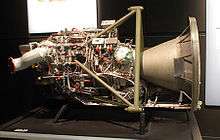S5.80
| Country of origin | USSR |
|---|---|
| Date | 1977-1986 |
| First flight | 1986-05-21 (Soyuz TM-1) |
| Designer | OKB-2, Anton Tavzarachvili |
| Application | Spacecraft main propulsion |
| Predecessor | 11D426 |
| Status | In Production |
| Liquid-fuel engine | |
| Propellant | N2O4 / UDMH |
| Mixture ratio | 1.85 |
| Cycle | pressure fed |
| Configuration | |
| Chamber | 1 |
| Nozzle ratio | 153.8 |
| Performance | |
| Thrust (vac.) | 2.95 kN (660 lbf) |
| Chamber pressure | 0.88 MPa (128 psi) |
| Isp (vac.) | 302 s (2.96 km/s) |
| Burn time | 890 seconds |
| Restarts | 30 |
| Gimbal range | ±5° |
| Dimensions | |
| Length | 1.2 m (47 in) |
| Diameter | 2.1 m (83 in) |
| Dry weight | 310 kg (680 lb) |
| Used in | |
| Soyuz since Soyuz-TM and Progress since Progress-M | |
| References | |
| References | [1][2][3][4] |
The S5.80 is a liquid pressure-fed rocket engine burning N2O4/UDMH with an O/F of 1.85. It is used for crew-rated spacecraft propulsion applications. It is currently used in the Soyuz-TMA-M spacecraft propulsion module KTDU-80, and its sibling, the S5.79 rocket engine, is still used as the main propulsion of the Zvezda ISS module. The S5.80 generates 2.95 kN (660 lbf) of thrust with a chamber pressure of 0.88 MPa (128 psi) and a nozzle expansion of 153.8 that enables it to achieve a specific impulse of 302 s (2.96 km/s). It is rated for 30 starts with a total firing time of 890 seconds. The engine, without the pressurization system or propellant tanks, weighs 310 kg (680 lb) and is an integrated unit that is 1.2 m (47 in) long with a diameter of 2.1 m (83 in).[4]
Versions
This engine has been used with certain variations in manned Russian space program since the Salyut 6 in Soviet times. The three main versions are:
- 11D426: Used as the main orbit correction engine of the Soyuz-T it was part of the integrated propulsion module KTDU-426 which was the big innovation introduced with that series.[5] It enabled using fewer engines, increasing the reliability and reducing the weight of the spacecraft using a dual string redundant pressurization and propellant feed system for the main propulsion and the reaction control system. Since the latter could be used to de-orbit the spacecraft, it eliminated the need for backup orbital correction engine like the KTDU-35 required.[1][3][6]
- S5.79 (AKA KRD-79): The orbit correction propulsion module of the second generation DOS stations, the Salyut-6 and Salyut-7 space stations, the Mir Core Module and the Zvezda ISS module. It was designed by KB KhIMMASH under RKK Energia specification based on the 11D426 design. It has improved life and restart capabilities, and is offered in a single compact unit. Each station has two of such engines.[1][7]
- S5.80: An evolution of the 11D426 and S5.79 it is used on the KTDU-80 propulsion module that has been a staple of all Soyuz since the Soyuz-TM and Progress since the Progress-M. It has slightly reduced thrust but improved specific impulse, while improving engine life over the 11D426.[1][3][8]
| Engine (SKD) | 11D426 | S5.79 | S5.80 |
|---|---|---|---|
| Propulsion module | KTDU-426 | KRD-79 | KTDU-80 |
| Development | 1968–1974 | 1968-1977 | 1977–1986 |
| Engine Type | Liquid pressure-fed rocket engine | ||
| Module | integrated spacecraft propulsion, pressurization and attitude control system | main propulsion engine | integrated spacecraft propulsion, pressurization and attitude control system |
| Propellant | N2O4/UDMH with 1.85 O/F ratio | ||
| Thrust (SKD) | 3.09 kN (690 lbf) | 3.09 kN (690 lbf) | 2.95 kN (660 lbf) |
| isp | 292 s (2.86 km/s) | 293.7 s (2.880 km/s) | 302 s (2.96 km/s) |
| Chamber Pressure | 0.88 MPa (128 psi) | 1.75 MPa (254 psi) | 0.88 MPa (128 psi) |
| Nozzle | 1 | 1 | 1 |
| Expansion Ratio | 153.8 | ||
| Burn time | 570s | 2700s | 890s |
| Ignitions | 40 | 70 | 30 |
| Mass | 270 kg (600 lb) | 38.5 kg (85 lb) | 310 kg (680 lb) |
| Length | 1,200 mm (47 in) | 840 mm (33 in) | 1,204 mm (47.4 in) |
| Diameter | 2,100 mm (83 in) | 550 mm (22 in) | 2,100 mm (83 in) |
| Uses | Soyuz-T | Salyut-6, Salyut-7, Mir Core Module, Zvezda | Soyuz-TM Soyuz-TM Soyuz-TMA Soyuz-TMA-M Progress-M Pirs Poisk |
| References | [1][2][6][7][8][9][10] | ||
See also
References
- 1 2 3 4 5 "Двигатели 1944-2000: Авиационные, Ракетные, Морские, Промышленные" [Aviadvigatel 1944-2000: Aviation, rocketry, naval and industry] (PDF) (in Russian). pp. 75–81. Retrieved 2015-07-25.
- 1 2 Brügge, Norbert. "Spacecraft-propulsion blocks (KDU) from Isayev's design bureau (now Khimmash)". B14643.de. Retrieved 2015-06-02.
- 1 2 3 Pillet, Nicolas. "Le système de propulsion du vaisseau Soyouz" [The propulsion system of the Soyuz spacecraft] (in French). Kosmonavtika.com. Retrieved 2015-07-14.
- 1 2 RKK Energia (June 1999). "3.17. Комбинированная Двигательная Установка (КДУ) (Combined Propulsion System)". Soyuz Crew Operations Manual (SoyCOM) (ROP-19) Final. NASASpaceFlight.com. pp. 122–129. (subscription required (help)).
- ↑ Chertok, Boris (May 2009). "Chapter 18 — Birth of the Soyuzes". Rockets and People Vol. 3 — Hot Days of the Cold War (PDF). Volume 3 (NASA SP-2006-4110). NASA. p. 562. ISBN 978-0-16-081733-5. Retrieved 2015-07-15.
- 1 2 "KDU-426". Encyclopedia Astronautica. Retrieved 2015-07-25.
- 1 2 "KRD-79". Encyclopedia Astronautica. Retrieved 2015-07-25.
- 1 2 "KTDU-80". Encyclopedia Astronautica. Retrieved 2015-07-25.
- ↑ "Основные двигатели разработки КБХМ" [The main engines produced by KbKhA] (in Russian). Retrieved 2015-07-25.
- ↑ McDowell, Jonathan. "5.2: Russian engines". Jonathan Space Report. Retrieved 2015-07-25.
